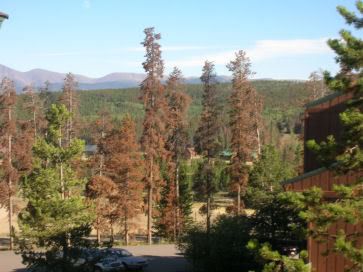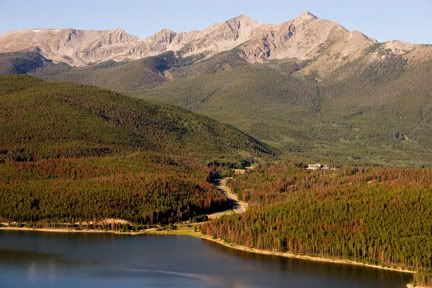Long-time readers may recall that I have been bemoaning the state of the forests around here, talking about the toll the drought and the dreaded pine bark beetle has taken.
There are a variety of beetles, each of which feeds upon a different species of pine. Three years ago, the forests around Prescott and Williams, AZ and the road from Flagstaff to the Grand Canyon turned red-brown seemingly overnight due to the pine bark beetle. This particular beetle feasted on pinon pines mostly, with a few forays into ponderosa pines.
Whenever we motored down to OmegaGranny's house, coming over the hill into the basin that Prescott sits in would make my heart ache. Once green hills were painted brown everywhere we looked. And, of course, as the acreage of trees killed grew, so did the fire danger.
Hereabouts, we have seen swaths of the telltale mark of the beetle infestation. I thought it was bad here.
Then we drove through Colorado.
(This isn't my picture; I grabbed it from the Summit County pine bark bettle infestation website.)
This was the view from our "hotel" room window (yes, it's blurry, sorry):

All those mountain in the backgrounds of those two pictures? They're covered with brown trees, brown and dying. Snow Mountain Ranch had a ban on burning (no campfires!), and they were aggressively removing acres...and acres...and acres of the trees.
It was ever so much worse than we've had it around here.
Why is it so bad? Well, there's the drought, of course. Pine bark beetles are always there, but usually, when they bore into the bark and start eating away, the (well-watered) sap running through the trees acts as a natural healing agent.
Then there's the fact that all these mountains were logged, and the trees that have grown back are all around the same age--sort of a monoculture, as it were. Many of the trees are nearing the end of their life cycles, and are more vulnerable to pest infestations.
There's also an almost century-long history of fire suppression--all for the best of reasons, at the time. It wasn't until the historic fires in Yellowstone National Park in 1988 that the Park Service and Forest Service began to significantly change their fire management practices.
To top it all off, the drought years have generally been warmer, and beetle larvae which would die off during cold months are more likely to survive.
Some tree-core research indicates that this has happened before, so it will probably happen again. In the meantime, these beautiful, lodgepole pine covered mountains have changed and will be changing drastically. We'll be back there next year, so maybe there will be another entry on this then.
Wander on over and check out this week's Carnival of Family Life; last week, OmegaGranny was featured, this week I popped one of my posts into the fray. Hi, visitors! Stop by and stay a while!
If you want to submit a post to the Carnival, the info is at PinkDiary.
Technorati: Forest health, pine bark beetle, Colorado, Southwest, drought





